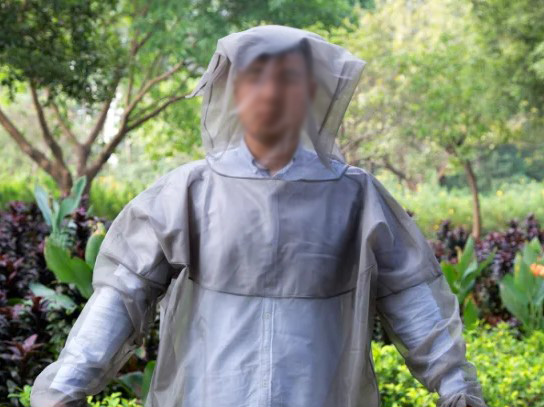Buzz Off, Skeeters!
Does it seem you need to spend your summer wrapped in protective netting whenever you go outdoors? Are you constantly slapping at those bothersome mosquitoes buzzing 'round your head? If not, thank your genetics, and consider yourself lucky. As for me, I had just about given up trying to spend a pleasant evening out of doors, and hiking in my favorite bird-watching spots was out of the question. These days, it's not just itching and irritation we have to worry about. While not common, with West Nile, Zika, and even malaria and dengue fever transmitted by mosquitoes in the US, those bites can be downright dangerous.
So what are we outdoorsy types to do besides swaddle ourselves with netting, or cover ourselves with (EPA-approved, but still) chemicals? Fortunately, you do have options! There are several natural plant-based solutions and some common-sense practices to deterring those pesky bugs. They won't necessarily kill them all, or completely eliminate your chance of getting bitten, but they will reduce the populations or make you a less attractive meal.
"Mosquito Plant" (Pelargonium citrosa)
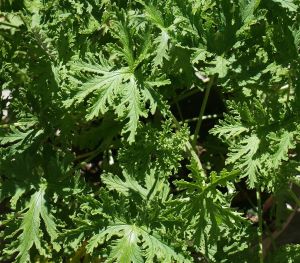
Perhaps you've heard of the "Mosquito Plant." They've been around in garden centers for years now, and maybe you've wondered if they live up to the hype. Well, I'm here to tell you that they do. Now don't get me wrong--one plant won't rid your entire yard of mosquitoes, but the oils in the leaves definitely DO have excellent mosquito repellent qualities.
What is the Mosquito Plant? It's actually one of a number of scented geraniums. Scented geraniums are similar to the popular zonal geraniums you plant in your window boxes every year, but the flower clusters are much smaller. In their favor, however, you will find varieties with scents of rose, mint, nutmeg, cinnamon and other spices, coconut, various fruits, and combinations of the aforementioned. The possibilities are seemingly endless. They often sport variegated leaves as well. The Mosquito Plant variety is "Citrosa," for the citronella scent. Will this plant keep mosquitoes away if you sit next to it? Studies say no, some users say yes. The important thing is to frequently brush the plant to release the oils, otherwise nothing happens.
I can say from personal experience that the oils in the leaf DO work. I was cleaning out a pond years ago, and being chewed to pieces in the process. I had no repellent sprays, but did have this plant and an aloe plant. I took them both and mashed them together well with a little water, and spread the concoction all over. Chancy thing to do without spot-testing first, I know, but I was desperate! It totally worked, and fortunately I suffered no ill-effects from the application itself. Remember to always spot-test when you're trying things like this--you never know what you might be allergic to!!
Lemon Scented Herbs
Anything lemon scented tends to repel mosquitoes, but releasing the oils is necessary for the best effect. One suggestion is to harvest leaves and stems and strew them on the ground or floor outside. As you and your guests tread on the foliage, the oils will be released. Or, burn some cuttings on the grill. Again, this won't work for hours on end or keep you bug-free, but anecdotal evidence suggests this can help. If nothing else, these plants smell wonderful!
- Lemon thyme (Thymus citriodorus) is a low growing evergreen perennial that's also terrific stuffed inside a chicken with some rosemary. It makes a mound about 6x10 inches, and also comes in an attractive variegated form. Doone Valley is a ground-hugging type that spreads well and has strong yellow variegation--perfect for growing between paving stones. This one you can rub your bare feet on!
- Lemon grass (Cymbopogon citratus) is a 6 foot tall tender perennial grass most commonly used in Thai recipes. It also makes a nice upright accent in a large container.
- Lemon balm (Melissa officinalis) is a perennial in the mint family that has a delicate lemon flavor and scent, and is delicious added to a cup of tea or on its own. It's one of the few herbs that will tolerate some shade, but watch out for the aggressive tendencies it inherited from its minty relatives.
- Lemon verbena (Aloysia citriodora) is a tender shrub, with a very Lemon verbena lovely, intense lemon scent. The flavor, with slight notes of mint and camphor, enhances baked goods and makes a tasty jelly. I've found the plant to be somewhat mite-prone, however, so beware.
- Lemon eucalyptus (Corymbia or Eucalyptus citriodora) is a tree in warmer zones (8-9 and up), but usually makes a 3 to 4 foot high and wide bush if kept in a container. The long narrow leaves are softer and thinner than the silver eucalyptus with which you may be familar. The essential oil produced from those leaves is 80% citronellal, and has more recently become a popular ingredient in many repellant sprays. Why not grow your own?
Other herbs to try are rosemary, lavender, lantana, eucalyptus, and mint. These strongly scented plants may be effective in masking human scent so the little buggers can't find you as easily.
Catnip (Nepeta cataria)
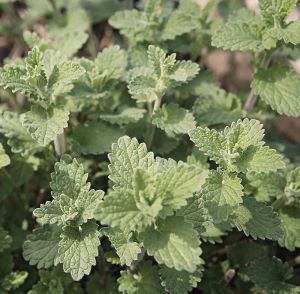
You may be growing a patch of catnip for Fluffy, but did you know that catnip oil repels mosquitoes? Nepetalactone, one of the essential oils in Fluffy's beloved hallucinogenic, was found by entomologists from the University of Iowa to be 10 times more effective than the same amount of DEET. It repels flies and cockroaches to boot. Catnip has also long been used as a medicinal herb for its calming properties--settling the stomach and promoting relaxation. The blooms attract bees and butterflies, and while it's not as refined or colorful as its popular oft-planted cousin, catmint, it is appropriate for cottage gardens, meadow plantings, and pollinator gardens.
Cutting back after first bloom will bulk it up a bit and promote more flowering. If, however, you're growing for repellent properties, you'll want to remove the flowers before they form to keep the highest concentration of oil in the foliage.
Tips for keeping mosquitoes at bay
It's pretty much common sense. They breed in stagnant water, no matter how shallow, and a new batch can hatch in as little as 4 days. Check your property after a rain for common sources of standing water, and beg your neighbors to do likewise:
- Birdbaths--keep water refreshed
- Clogged gutters
- Saucers under pots
- Kids toys
- Wheelbarrows
- Trash can lids
- Folds in grill and boat covers
- Fountains--keep them running or empty them
Mosquitoes prefer the cover of brushy areas and yard debris. Keep your grass cut appropriately, clear any piles of sticks, branches, or fallen leaves, and locate your compost pile as far away as possible from areas you frequent. For safe organic control of mosquito larvae where standing water is unavoidable, look for products containing bacillus thuringensis israelensis--a naturally occurring bacteria that is toxic to mosquito and fungus gnat larvae, but has no known effect on other species.
You might be able to encourage something to chow down on those remaining mosquitoes--bats and hummingbirds may do the trick. A bat can potentially devour thousands of mosquitoes in an evening, among many other insects you may find undesirable.
Installing a bat house is easy and will also help the declining bat populations by providing them a safe place to roost during the day. If bats are just too creepy for you (I know, some folks simply don't like winged mammals flitting about), try inviting some hummingbirds to dine. They love nectar, but also eat lots of small insects and spiders.
Mosquito, Tick, and Flea Repellent by I Must Garden: This all natural DEET-free mosquito, flea, and tick repellent is safe to use around children and pets. Kills mosquito larvae and insects on contact and repels up to 30 days. For use in yards, gardens, playgrounds, around pools and decks. Made of Cedar, Lemongrass, Thyme, Citronella, Rosemary, Geraniol, Mint, Garlic, & Vegetable Oil. Also kills gnats, chiggers and no-see-ums. Comes in a 32 oz spray bottle, 32 oz concentrate, or 32oz hose-end spray concentrate (easiest to use for a large area).
If you do get bitten, these products may soothe your skin
Handcrafted English Lavender Soap: With botanical oils, kaolin clay, ground lavender flowers, and essential oils of lavender and patchouli. Simple and pure, and a fragrance to die for. Some of this sits on a shelf next to my desk, so I can vouch for that!!
Happy Wanderer Natural Soap for Rash Relief: With jewelweed and plantain. Jewelweed is a native American plant known to reduce the itchiness and spread of poison ivy. Plantain soothes and encourages regeneration of skin, which may reduce scarring.
Gardener's Hand Soap: The perfect way to clean and renew your hands after a day in the garden. With cornmeal, kaolin clay, and skin-soothing comfrey and essential oils of lavender and tea tree.
Soap Gift Set: Includes 3 handcrafted soaps: English Lavender, Gardener's Hand Soap, and Happy Camper. Keep some, gift some!
Hello, Hummers!
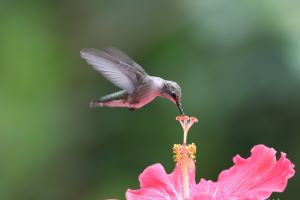
Who doesn't love a hummingbird? They're adorable teeny-tiny bundles of energy, whose speed and amazing aerial acrobatics endear them to birders and non-birders alike. One of the most delightful summer pastimes is feeding and watching these playful feathered creatures.
But what if you don't have room for a garden, or your garden is already landscaped with nice green things that leave you hummer-less? Not to worry--there's plenty of ways you can encourage these hungry birds to pay you a visit.
Hummingbirds spend up to 90% of their hovering time in feeding, burning a tremendous number of calories in the process. That's why they feed on high-calorie, sugary nectar, which you can provide.
You can place a hummingbird feeder almost anywhere--in the garden, on a balcony, on your deck, in a tree-- trust me, they'll find it. All you need is a suitable hook.
Follow these tips for placing your feeder
- Convenient to you: This isn't as selfish as it sounds. If you can't get to it easily, you won't be as likely to keep it clean and filled. They'll come to rely on you, so you don't want to let them down. Some drips are inevitable, so don't hang over your outdoor furniture.
- Visible and accessible to them: Don't bury it in the greenery, or hide it under the eaves. Make sure they see it, and give them adequate space to maneuver. Hummingbirds are attracted to the color red, so anything red nearby is a plus.
- Safety: Make sure the kitty can't reach it, and keep away from windows to avoid accidents.
- Privacy: Station at a distance from other feeders, as larger birds may discourage them. They are territorial and aggressive by nature when feeding.
- Shade: Nectar can spoil on very hot days, so some shade during the hottest part of the day will keep it cooler.
Caring for your feeder
- Change the nectar every 3-5 days
- Clean with hot, soapy water once a week, more often if temperatures are above 90 degrees.
- If the liquid should become cloudy or moldy, clean immediately.
Plants to Attract Hummingbirds
If that kind of maintenance seems too burdensome, you can still invite the hummingbirds with more traditional means--plants! With their long beaks and probing tongues, hummers usually look for long, tubular flowers. As mentioned before, their vision is especially sensitive to colors in the red through yellow range, but they feed on flowers in other hues as well. Just pop a few pots on your porch, or a box or basket on your balcony, and plant these sure-to-please nectar producers:
Salvias, perennial or annual and easily grown, are a favorite. Salvia is a large genus in the mint family, with over 1000 species. Usually sun-loving and drought tolerant, they are also generally deer resistant. Some are hardy perennials, like Meadow Sage, that bloom most heavily in the spring before the hummingbirds have arrived. Here we'll suggest a few good summer blooming candidates:
- Salvia guaranitica Black and Blue is a tender perennial with intense blue flowers with black calyxes and stems--exciting mixed with almost anything in a container, and stunning en masse.
- Little leaf sage, S. microphylla varieties and hybrids, like 'Maraschino' and 'Hot Lips' are popular.
- Salvia farinacea, Mealycup Sage, is a commonly planted tall bedding plant--'Victoria Blue' is the old standby. Newer varieties, like 'Evolution', offer more vibrant color, larger flowers, and better habit.
- Traditional red bedding Salvia splendens, or scarlet sage, has come a long way these days, and can be found in purple, orange, burgundy, mauve, cream, and bi-colors. There's even a yellow and green variegated variety--'Dancing Flame.'
- One of my personal favorite salvias is Salvia coccinea 'Lady in Red.' More delicate flowers and an airier habit than the somewhat coarse bedding sages, but plenty of color. Besides the hummingbirds, I love watching the goldfinches swarm the 2-3 foot stems for the seeds in late afternoon. They tend to reseed themselves, too, assuming the finches leave a few for next year!
- If you have a smaller space, consider Salvia Summer Jewel series. They're similar to 'Lady in Red,' but more compact at about 16-18 inches.
If you'd like to use native plants, go for red cardinal flower,Lobelia splendens, or blue Lobelia siphilitica. Monarda, or bee balm, will not only make the hummers happy, butterflies and bees will be pleased as well. These three appreciate plenty of water. If you need something a little more drought tolerant, choose penstemon, also called beardtongue, or kniphofia, which bears the fun common moniker of "red hot poker." Be sure to look for compact varieties if space is at a premium.
You certainly can't go wrong with a plant called hummingbird mint. Agastache is a delicate looking, yet tough, plant in the mint family. As with many mint family members, it boasts fragrant leaves and good deer resistance. Long spires of delicate flowers in shades of red, pink, orange and yellow bloom summer to fall on licorice-scented foliage. They offer lovely color and texture to mixed containers.
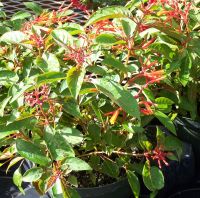
Two tropical plants worth seeking out are Hamelia patens and Russelia equisetiformis. Hummingbirds are big fans of both. Hamelia is often called firecracker plant or firebush. In Florida, they are often grown as hedge plants, which just shows you how many flowers they have in Florida--they can afford to just cut them off whenever they want! I am a jealous zone 7 gardener, can you tell?) The clusters of small tubular flowers are most often orange, and the glossy pointed leaves are deep green. There is a new golden-foliaged variety that brightens mixed containers.
The russelia also bears the common name, "firecracker plant." This one may be a little harder to find, but it's truly worth it. Incredible drought tolerance combined with an abundance of drop-dead gorgeous lipstick red flowers and long, needle-thin, bright green cascading stems make for one terrific plant. It needs so little water you could definitely grow this in a hanging basket.
In case you're unsure, I'll tell you that we had this plant at a nursery I worked for years 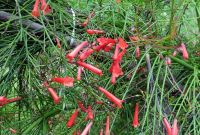 ago. One one-gallon plant must have fallen off the truck, because I found it about 2 weeks after the shipment arrived, kicking around the loading area, without its pot. It was a hot May in Maryland. It was fine. I have loved this plant ever since.
ago. One one-gallon plant must have fallen off the truck, because I found it about 2 weeks after the shipment arrived, kicking around the loading area, without its pot. It was a hot May in Maryland. It was fine. I have loved this plant ever since.
Most shoots will trail, but some will grow straight up, so it can look a little unkempt at times. You can prune them out if they bother you, but those shoots often flower abundantly. It's definitely not for those of you who prefer your annuals in neat rows and annually shear your boxwoods. But if you like something wild, wooly, and wonderful, give this one a try. You may also find a yellow- or peach-flowered variety, but for the hummers, stick to the red!
Other plants to consider:
- Petunia
- Calibrachoa
- Geranium
- Nicotiana (flowering tobacco)
- Verbena
- Impatiens
- Fuchsia
- Abutilon
- Cleome (spider flower)
- Snapdragon
- Mirabilis (Four O' Clocks)
- Hibiscus
- Mandevilla
- Dipladenia
- Allamanda
- Thunbergia vine
- Honeysuckle vine (natives preferred!)
- Morning glory
- Weigela
Remember that hummingbirds don't eat only nectar. They also eat small insects and spiders, so maybe they'll help with any aphids or other pests you might have in return for their free lunch!
Want to feed the hummers?
You can make nectar yourself, just thoroughly mix sugar and water in a 4 to 1 ratio. For example, one cup of water to 1/4 cup sugar. Adding food coloring is not necessary, and is no better for the birds than it is for us.
If you have a feeder with a tubed stopper on the bottom you will need enough nectar to completely fill the tube. These feeders work on a vacuum principle and if you do not fill the feeder full the vacuum will not form and the nectar will run straight out of the tube. On very hot days the liquid may expand and leak a bit--keeping it out of the sun is best.
For other types of feeders, mix only a small amount until the hummers find you and you can gauge how much they can eat before it's time to clean the feeder.
Our Feeders:
Pot de Creme Shelter Hummingbird Feeder: glass with rustic tin roof; 2 red glass flower feeding stations; 6 oz capacity
Pot de Creme Feeder: glass with 2 red flower glass feeding stations; 6 oz capacity
Bloom Perch Feeder: glass with 3 red glass flower feeding stations and metal perches; 16 oz capacity
Bloom Feeder: glass with 3 red flower glass feeding stations; 16 oz capacity
Mini Blossom Feeder, staked or hanging: glass with one red glass flower feeding station; 4 oz capacity
Droplet Art Glass Feeder: many striking colors, each with one red flower glass feeding station; 4 oz capacity
Our Feeder Accessories:
12 inch Branch Hook: perfect for hanging your feeder from a tree or any other support
Ant Moat: whimsical umbrella-shaped design adds charm while keeping pesky ants out of your feeder.
Hummingbird Feeder Stoppers with ball bearing
Hummingbird Feeder Stoppers without ball bearing
Beeproof Flower Replacement Feeder Tubes
Hummingbird Feeder Cleaning Brushes: Large for feeders, small for feeder tubes


